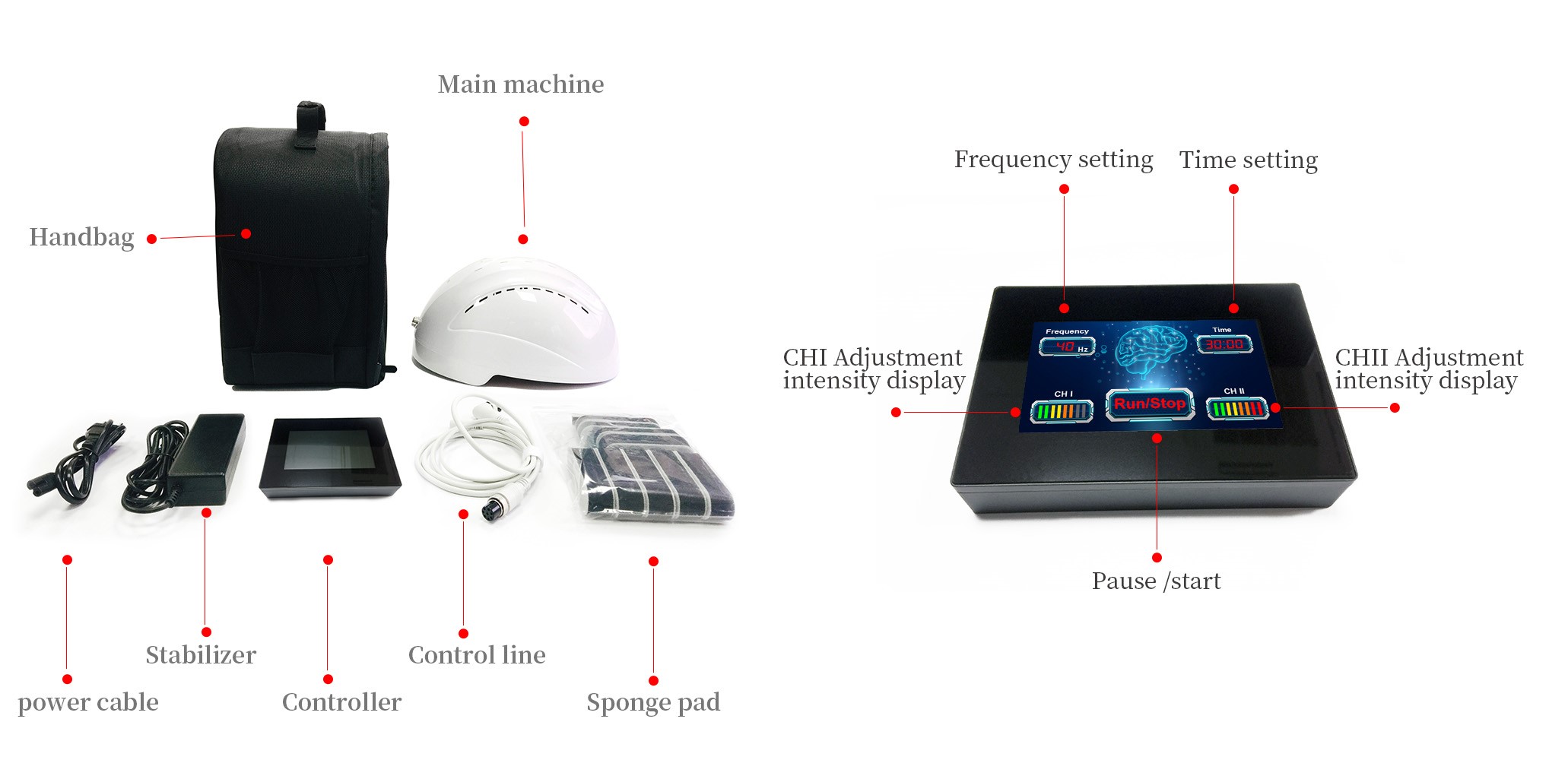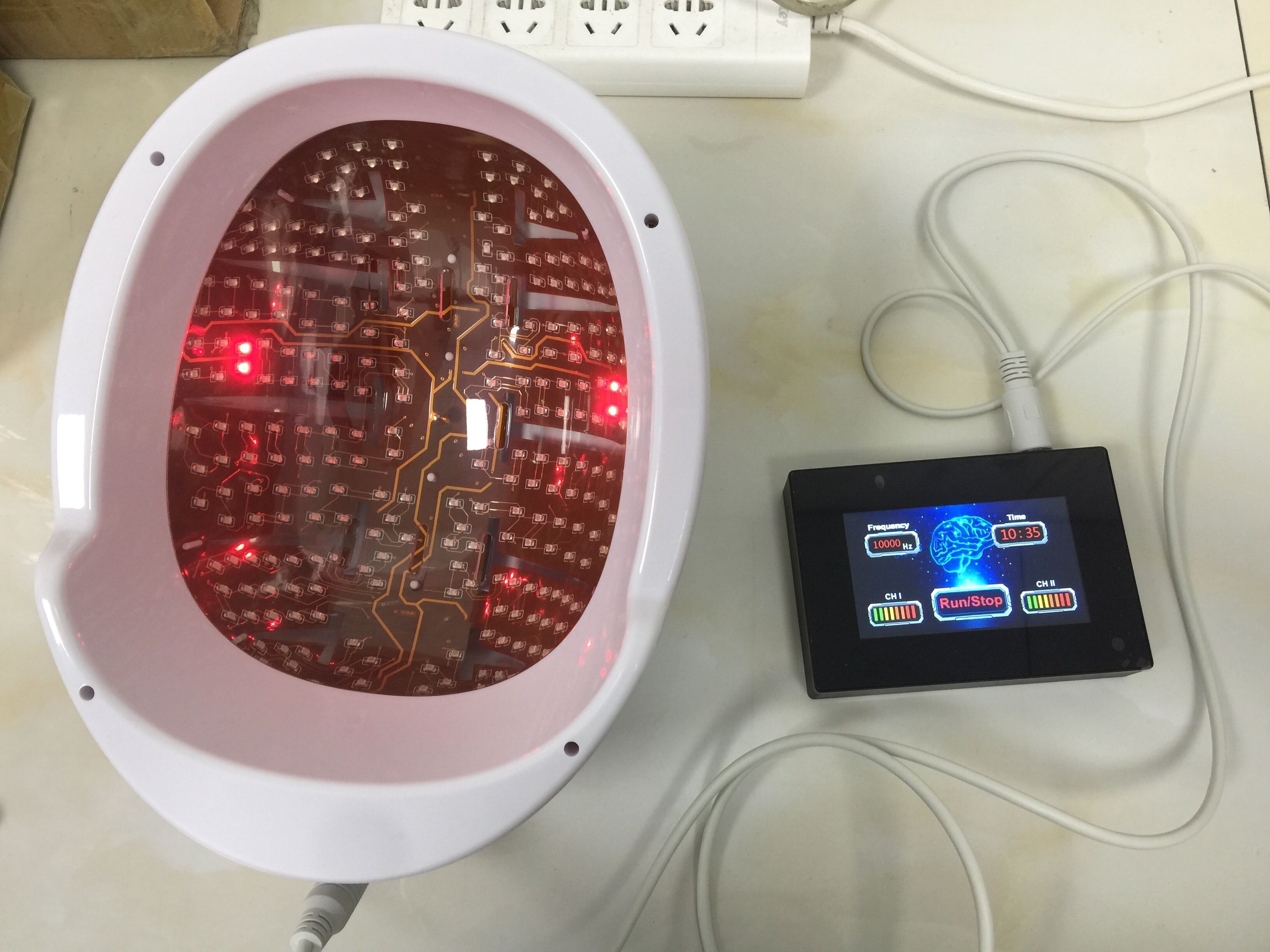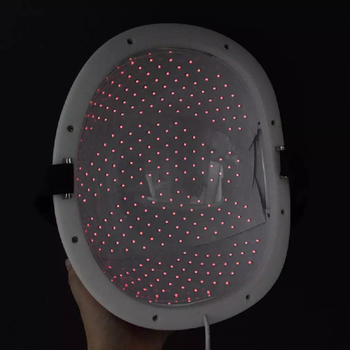Summer Body Photobiomodulation Helmets
Summer Body Photobiomodulation Helmet Advanced 810nm
- SKU:
- photohelmetadvanced
- Weight:
- 1.00 LBS
Description
Brain Photobiomodulation Helmet Advanced

The Advanced Helmet Multi Frequency 0 - 20,000 Hz with Touchscreen Controller
Our helmet device works with 810 nm infrared, it can extend through the skull into the brain, offers an unique array of neurological benefits.
Introduction
Photobiomodulation (PBM) describes the use of red or near-infrared light to stimulate, heal, regenerate, and protect tissue that has either been injured, is degenerating, or else is at risk of dying. One of the organ systems of the human body that is most necessary to life, and whose optimum functioning is most worried about by humankind in general, is the brain.
The brain suffers from many different disorders that can be classified into three broad groupings: traumatic events (stroke, traumatic brain injury, and global ischemia), degenerative diseases (dementia, Alzheimer’s and Parkinson’s), and psychiatric disorders (depression, anxiety, post traumatic stress disorder). There is some evidence that all these seemingly diverse conditions can be beneficially affected by applying light to the head. There is even the possibility that PBM could be used for cognitive enhancement in normal healthy people.
In this transcranial PBM (tPBM) application, near-infrared (NIR) light is often applied to the forehead because of the better penetration (no hair, longer wavelength).
PBM therapy was developed more than 50 years ago; however, there is still no common agreement on the parameters and protocols for its clinical application. Some research teams have recommended the use of a power density of less than 100 mW/cm2 and an energy density of 4 to 10 J/cm2 [11]. Others groups recommend as much as 50 J/cm2 at the tissue surface [11]. Parameters like wavelength, energy, fluency, power, irradiance, pulse mode, treatment duration, and repetition rate can be applied in a wide range. Our present preliminary results showed a clear response of cerebral rSO2 in relation to the LED stimulation. However, it has to be mentioned that the temperature increased significantly, and these effects have to be taken into account in further studies in detail. There is also the fact that ineffective studies in cells with high mitochondrial activity appear to be due more often to over-dosing than to under-dosing [11]. Therefore, clinical studies concerning the optimal stimulation doses are necessary.
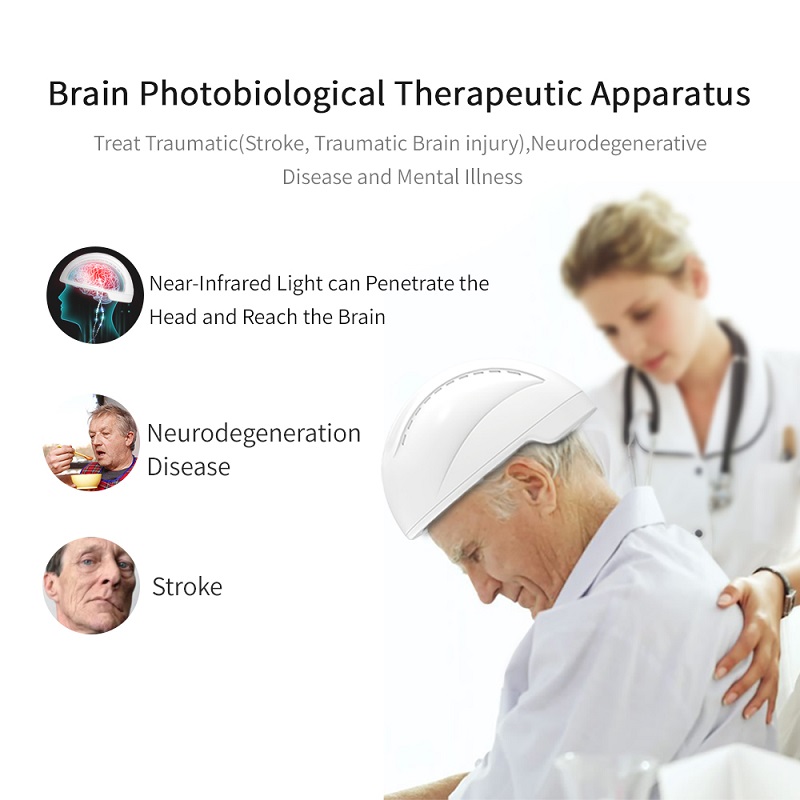
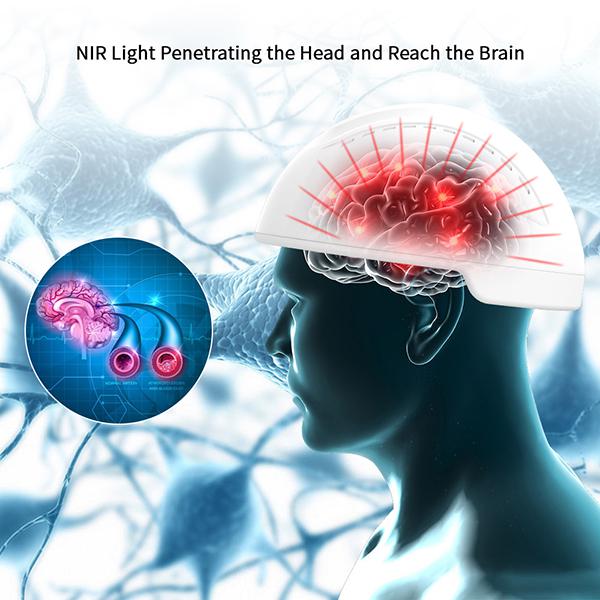
|
LED Wavelength - Multi Frequency |
810 nm 0-20,000 Hz Frequency Programmable - Touchscreen |
|
Led Quantity |
256pcs |
|
Power(total helmet) |
15 W Power Adjustable 25%, 50%, 75%, 100% |
|
Power(one LED) |
50 mW |
|
Power |
24 mW/cm2 |
|
Certificate |
CE, FDA |
|
OEM |
Support |
|
Color |
White/Black |
|
Option Time |
6-12-18-24-30 minutes |
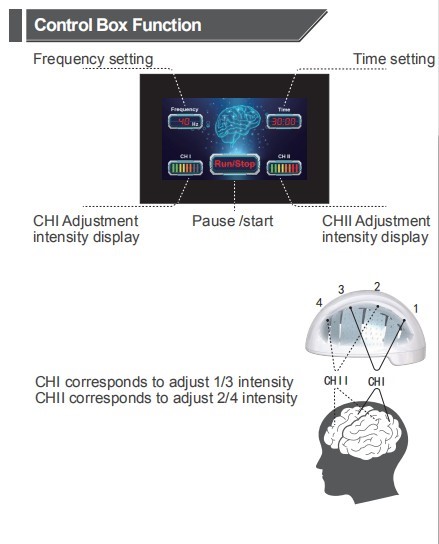
FDA Registered Lamp, Infrared, Therapeutic
Subpart F--Physical Medicine Therapeutic Devices
| Sec. 890.5500 Infrared lamp. |
|
(a) Identification. An infrared lamp is a device intended for medical purposes that emits energy at infrared frequencies (approximately 700 nanometers to 50,000 nanometers) to provide topical heating. (b) Classification. Class II (performance standards). |
1. The 810 nm wavelength has the ability to extend through the skull to the brain, promoting recovery.
2. 810 nm wavelength is used on patients with severe depression and anxiety for feeling of wellbeing.
3. NIR light is absorbed by cytochrome C oxidase in mitochondria.
4. Increased blood flow, energy, neuroprotection and less inflammation. What is Photobiomodulation?
Photobiomodulation (PBM) describes the use of red or near-infrared light to stimulate, heal, regenerate, and protect tissue that has either been injured, is degenerating, or else is at risk of dying. One of the organ systems of the human body that is most necessary to life, and whose optimum functioning is most worried about by humankind in general, is the brain. The brain suffers from many different disorders that can be classified into three broad groupings: traumatic events (stroke, traumatic brain injury, and global ischemia), degenerative diseases (dementia, Alzheimer’s and Parkinson’s), and psychiatric disorders (depression, anxiety, post traumatic stress disorder). There is some evidence that all these seemingly diverse conditions can be beneficially affected by applying light to the head. There is even the possibility that PBM could be used for cognitive enhancement in normal healthy people. In this transcranial PBM (tPBM) application, near-infrared (NIR) light is often applied to the forehead because of the better penetration (no hair, longer wavelength).
Abstract:
A new piece of equipment for LED (light emitting diode) brain photobiomodulation is introduced. Preliminary results from regional cerebral oxygen saturation and from thermography are shown before, during and after stimulation.
The procedure offers a new way to quantify the biological effects of a possible innovative therapeutic method. However further measurements are absolutely necessary.
The Brain Photobiomodulation Machine is a therapeutic instrument based on the principle of photobiomodulation. It has a good therapeutic effect on traumatic events (stroke, traumatic brain injury, and global ischemia), degenerative diseases (dementia, Alzheimer’s and Parkinson’s), and psychiatric disorders (depression, anxiety, post traumatic stress disorder)
Brain photobiomodulation (PBM) with red to near-infrared (NIR) light emitting diodes (LED) could be an innovative therapy for a variety of neurological and psychological disorders. Red/NIR light can stimulate mitochondrial respiratory chain complex IV (cytochrome c oxidase) and increase ATP (adenosintriphosphate) synthesis. In addition, light absorption by ion channels leads to the release of Ca2+ and to the activation of transcription factors and gene expression. Brain PBM therapy could improve the metabolic capacity of neurons and is able to stimulate anti-inflflammatory, anti-apoptotic and antioxidant responses as well as neurogenesis and synaptogenesis. Findings suggest that PBM may enhance, for example, the frontal brain functions of older adults in a safe and cost-effective manner.
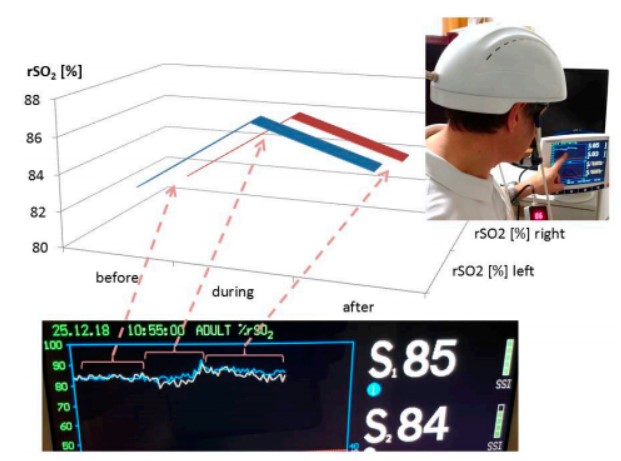
Note the increase in the regional cerebral oxygen saturation during and after stimulation on the left and right side.
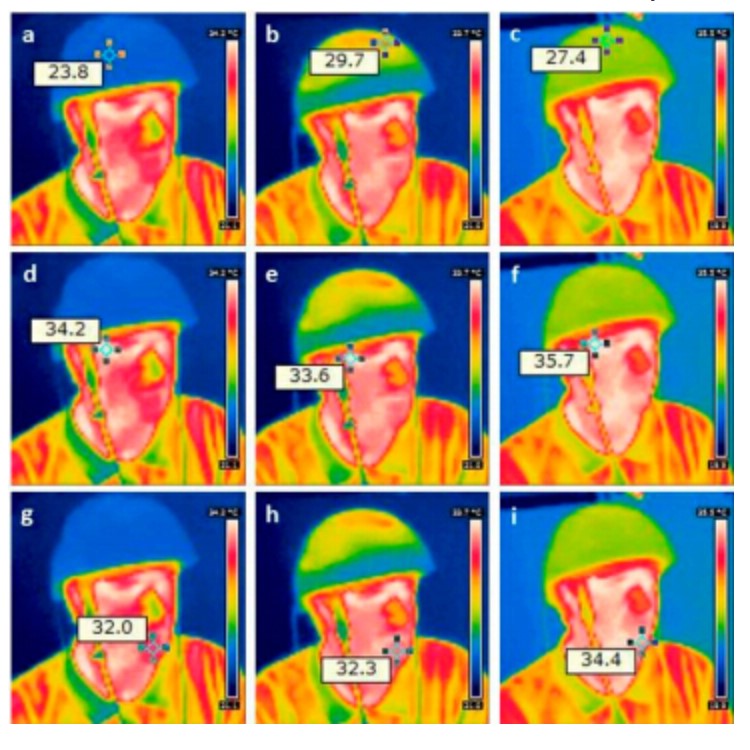
Results from thermal imaging of the first pilot measurement using the new stimulation helmet. Note the increase in temperature on the helmet (upper row; a before, b during, and c after stimulation) on the forehead (middle row; d–f) and on the chin (lower row; g–i).
Main Function and current studies for possible use
- Traumatic events (stroke, traumatic brain injury, and global ischemia).
- Degenerative diseases (dementia, Alzheimer’s and Parkinson’s).
- Psychiatric disorders (depression, anxiety, post traumatic stress disorder).
Contraindication
- Avoid direct exposure to the eyes, pregnant woman’s abdomen, melanoma, brown spots.
- Taboo patients with early and middle stage malignant tumors.
- Contraindications to patients with acute bleeding disorders.

Reference: Brain Photobiomodulation – Preliminary Results from Regional Cerebral Oximetry and Thermal Imaging
Please read the following notes carefully beforehand
Please follow the manufacturer to develop a special transformer and power outlet to ensure the normal operation of the product.
Do not place the product in direct sunlight or near flammable materials.
Do not disassemble it yourself to avoid electric shock.
Do not scrub with an acidic or alkaline cleaner.
Do not use the product in a place with high temperature or high humidity.
Disconnect the power and unplug the power adapter when you are not using the product or when you are absent.
Do not use the power cord for knotting, bundling, etc., and do not use when the outer skin is damaged.
Do not use the multi-function adapter socket.
Make sure the power outlet meets manufacturers specifications
In the following situations, please unplug the power cord and stop using it.
* When the product and power adapter are wet or drenched.
* Safety factors such as smoke and sparks occur on the line.
*When the power cord or power plug is damaged or broken.
(If you have any questions, please contact the after-sales customer service staff
This product is guaranteed for one year free service under normal use. If the warranty period is exceeded, a certain part cost will be charged.
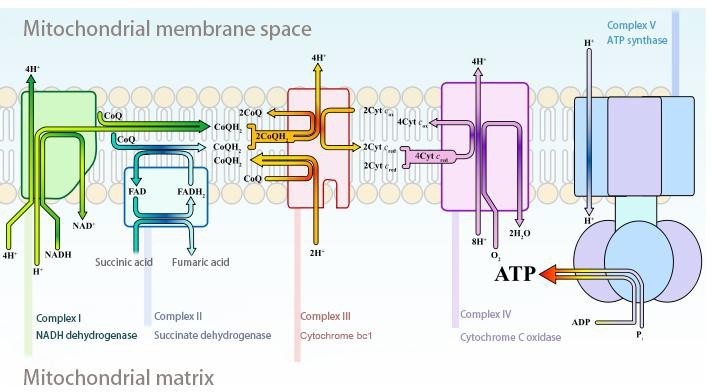
Research indicates that cytochrome c oxidase(CCO, also known as complex IV) is a key photo-acceptor of irradiation in the red to near infrared range, responsible for the final reduction of oxygen to water using the electrons generated from glucose metabolism.
There are several mechanisms associated with promoting physiological change through photobiomodulation therapy (PBMT). The wavelengths primarily used with PBM is within the near-infrared range of the electromagnetic spectrum with a sufficient power density. When hypoxic/impaired cells are irradiated with low level NIR photons, there is increased mitochondrial adenosine tri-phosphate (ATP) production within their mitochondria.
Another change is the release of nitric oxide(NO) from the hypoxic/impaired cells. Neurons are cells that contain mitochondria and nitric oxide.
In hypoxic neuronal cells, cytochrome-C oxidase (CCO), a membrane-bound protein that serves as the end-point electron acceptor in the cell respiration electron transport chain, becomes inhibited by non-covalent binding of nitric oxide. When exposed to NIR photons, the CCO releases nitric oxide, which then diffuses outs of the cell – increasing local blood flow and vasodilation.
Following initial exposure to the NIR photons, there is a brief burst of reactive oxygen species (ROS) in the neuron cell, and this activates a number of signaling pathways. The ROS leads to activation of redox-sensitive genes, and related transcription factors including NF-κβ.5, 6 The PBMT stimulates gene expression for cellular proliferation, migration, and the production of anti-inflammatory cytokines and growth factors.
This product is guaranteed for one year free service under normal use. If the warranty period is exceeded, a certain part cost will be charged.
Beta Brainwave Frequencies: 13-40 Hz
The beta brainwave is the predominant frequency when we are fully awake and alert.
Active awareness directed to the outer world.
Beta brainwaves are present during stress, paranoia, worry, fear, and anxiety.
They are also present during hunger, depression, irritability, and moodiness.
Insomnia is the result of producing excessive beta brainwaves.
Associated with excessive "mental chatter" and self-destructive impulses.
Too much time in the beta state weakens the immune system.
Beta brainwaves make up much of our conscious mind.
Alpha Brainwave Frequencies: 7-13 Hz
The alpha state is where meditation and relaxation begins.
We start to encounter the wealth of effortless creativity flowing just beneath our conscious state.
Awake but deeply relaxed.
Studies have shown the alpha state has been associated with "peak performance." Elite athletes produce alpha brainwaves prior to concentrated performance
(shooting a free throw, hitting an important golf shot). Amateur athletes produce more of the anxious beta brainwaves.
In the alpha state we learn, process, memorize and recollect large sums of information fast and with peak effectiveness.
Highly creative people have been shown to have "bursts" of alpha brainwaves when they have good ideas.
Alpha brainwaves are thought to make the brain "act young" again.
In the alpha state fears, habits, and phobias begin to melt away.
Alpha brainwaves bring an effortless sense of comfort, peace, and harmony.
Best for "super learning".
The alpha state is the first layer of our subconscious mind.
A gateway to deeper states of awareness.
Theta Brainwave Frequencies: 4-7 Hz
Theta brainwaves become prominent when we go deeper into meditation and relaxation - almost trance-like.
Here, brain activity decelerates to the threshold of the sleep stage.
One of the more indescribable and wonderful realms we can explore.
The theta state produces flashes of creative visualization through vivid imagery.
In this state we feel much more open and connected to other people.
People often report a feeling of floating while producing theta brainwaves.
Theta brainwaves are thought to bring out a person’s dormant extrasensory perception (ESP) skills.
The theta state heightens problem-solving skills.
Having dominant theta brainwaves are correlated with insight and intuition.
Theta brainwaves bring inspired thought and increased motivation.
Sometimes long-forgotten memories come to the surface.
Children have strong theta brainwaves, which helps to explain their superior ability to learn.
Theta is briefly experienced as we climb out of the depths of delta upon waking, or when falling asleep.
The theta state is the deeper sub-conscious to super- conscious part of the mind.
Delta Brainwave Frequencies: 0-4 Hz
The delta state is associated with "no thinking" during deep, dreamless sleep.
Delta brainwaves are very rewarding.
Delta is said to be the entrance to non-physical states of reality.
A crucial state for renewal, healing, and rejuvenation.
The immune system strengthens in the delta state.
The delta state is the unconscious/super-conscious part of our mind.
Many scientists believe this state to be the most beneficial.
No claims are made or implied other than registered intended use for topical heating. Information is for research purposes only.
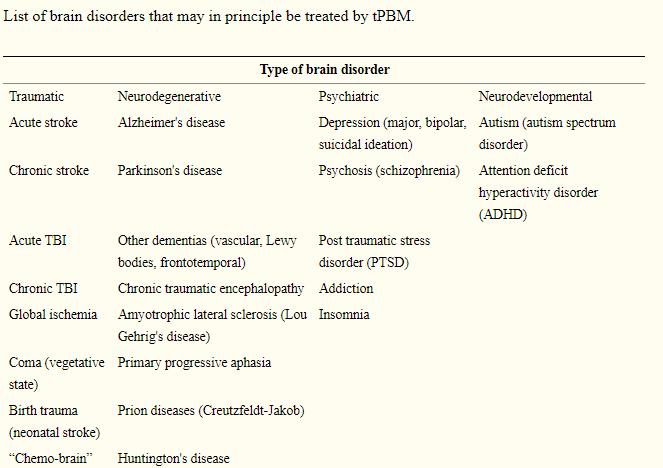
References for Research
PBM for Stroke
https://www.ncbi.nlm.nih.gov/pubmed/30983970
https://www.ncbi.nlm.nih.gov/pubmed/29472564
https://www.ncbi.nlm.nih.gov/pubmed/22967677
PBM for Traumatic Brain Injury
https://www.ncbi.nlm.nih.gov/pubmed/28001756
https://www.ncbi.nlm.nih.gov/pubmed/26990361
https://www.ncbi.nlm.nih.gov/pubmed/25966949
PBM for Alzheimers
https://www.ncbi.nlm.nih.gov/pubmed/27815990
https://www.ncbi.nlm.nih.gov/pubmed/28186867
https://www.ncbi.nlm.nih.gov/pubmed/31050950
PMB for Parkinsons
https://www.ncbi.nlm.nih.gov/pubmed/25462595
https://www.ncbi.nlm.nih.gov/pubmed/19534794
https://www.ncbi.nlm.nih.gov/pubmed/26484876
PMB for Psychiatric Disorders
https://www.ncbi.nlm.nih.gov/pubmed/22334326
https://www.ncbi.nlm.nih.gov/pubmed/19995444
https://www.ncbi.nlm.nih.gov/pubmed/29307593
This product is sold to private members only









